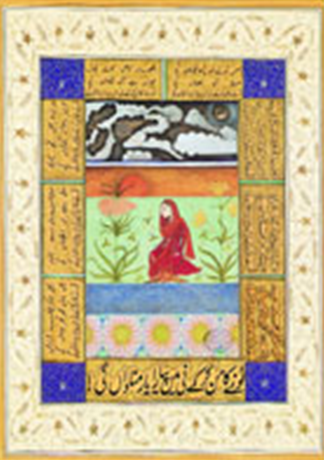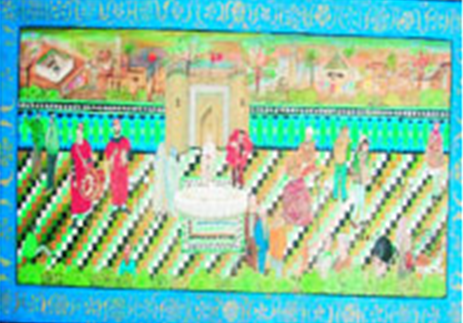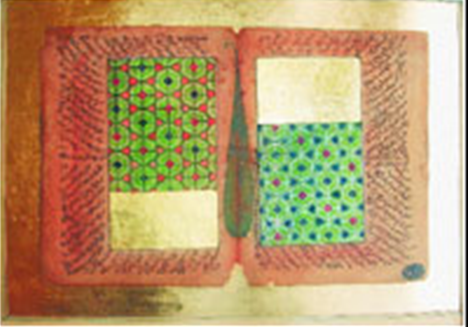Fatima Zahra
This is a collection of articles archived for the excellence of their content. Readers will be able to edit existing articles and post new articles directly |
Fatima Zahra
MINIATURE: Practises what she teaches
By Asif Noorani
The exhibition of Dr Fatima Zahra’s exquisite miniatures, on the theme of Sufism, was held last month from the 18th to the 26th in Karachi’s Chawkandi Gallery, but the tumultuous events that followed soon after make one feel that the paintings were on display ages ago. The Cambridge-based miniaturist and scholar of Islamic art, surprisingly not that well known in Karachi, at least, did not get the kind of coverage she deserved by the media.
The first painting that one saw as one entered the gallery shows a pair of cypress trees, one against a plain backdrop and the other with an attractive geometric design in the background. The conical tree points towards the sky giving the impression that it is aiming at Heaven. One may like to recall that cypress trees are symbols of eternity and divinity and are mentioned very often in Persian Sufi poetry, especially in the verses of Maulana Rumi.
Another fascinating composition is the one that features the great Persian poet Hafiz Shirazi. Most notable in the composition apart from the figure of the poet is the enchanting geometric patterns. The painting has all the three notable features of Islamic art — calligraphy, geometric patterns and Islimi (the flora and the fauna), which is called Arabesque in the West.
Two other major Sufi figures that appear in her miniatures are Maulana Rumi and Bulleh Shah. The face of Rumi comes alive in the composition. “I painted it with love and devotion,” she told an art lover. Equally attention-grabbing was the miniature, embellished with lines from Bulleh Shah’s poetry.
Due to limited space one can’t discuss her other fascinating miniatures that were on display but suffice it to say that at a time when miniaturists are harping on the themes of kings and courtiers in the traditional manner or are depicting contemporary themes, here is one who has opened the window to the scintillating world of Sufism with all its symbols, metaphors and allegories.
Zahra is also trying to revive the art of illustrating books through miniatures. A slim volume that was on sale at the exhibition was Kingdom of Joy: Tales from Rumi. Published in the UK by the noted London-based Islamic scholar Dr Abdur Rahman Azzam, it carries a preface by the illustrious late Annemarie Schimmel. The illustrations by Zahra are in keeping with the Persian and Mughal traditions. Incidentally, it is still on sale at Chawkandi and so is a lovely print of her miniature featuring the verse of Bulleh Shah. It is deceptive in the sense that it looks like the original painting even from as close a distance as two feet.
Zahra travels back and forth to Lahore where her parents and in-laws live, and as she says she has her roots in the country. One of her current assignments is to document all the manuscripts of the Shahnama in Pakistan. More about it later.
Born in Sahiwal to an educator father and a mathematician mother she was brought up by her paediatrician aunt, who had no children of her own and her maternal grandmother, a poet and artist. The aunt was a fine tapestry artist. Their influence on Zahra was immense.
She did her Intermediate Science in Karachi before moving to Lahore to graduate in fine arts from the National College of Arts. While she was still in the process of submitting her final thesis she got the good news that she was granted admission to the Royal College of Arts, London, to do her Master’s in Visual Islamic and Traditional Arts, which she did with distinction.
Zahra then went on to do a PhD in the same faculty. The course demanded that 70 per cent of her work be based on practice for which she submitted her paintings based on Bulleh Shah’s kaafis. Her thesis, forming the remaining part, was on the traditional methods and materials of Indo-Mughal and Persian manuscript illustrations.
She is these days working on part-time basis for the Cambridge Shahnama Project funded by the Arts and Humanities Research Council of UK and the project head is Dr Charles Melville, head of Persian in the University of Cambridge’s Department of Asian and Middle Eastern Studies. As mentioned earlier, she is documenting all the manuscripts of the Shahnama in Pakistan for the Shahnama Project data base, whether they are in museums or in private collections, all over Pakistan and are luckily “in tact”, to use her own words. Most of them have been illustrated by artists of their times.
“How come we don’t get to know the names of the artists who have worked on miniatures?” I query.
“Well, we have had no tradition of signing the paintings. It’s a Western tradition, which we have now adopted. Modesty was ingrained among the artists of the past centuries. Also please remember miniatures were not done by one artist, there was a team, each artist specialising in a particular aspect, such as painting of figures, making geometric and floral designs, drawing borders etc. There was, however, a head of the team but credit was given to the patron, or call it a sponsor, if you like,” comes the answer.
At present Fatima Zahra teaches the art of the book and miniature painting to post-graduate students and also mature students, which encompasses designing, drawing borders, illustrating the text. It is a part of the World Art Programme at the British Museum London and it is in collaboration with Berbeck College, University of London.
She is also developing courses on the narrative, surface design and embellishments for designing interiors, inspired by the Persian, Mughal and Indian miniature paintings.
Her first book on the technique of Indian, Mughal and Persian miniature paintings will be published soon, and she is also working on interactive art books for children.
Moreover, she regularly conducts workshops on Indian, Mughal and Persian paintings at the British Museum and at the Victoria & Albert Museum, London, just to mention two. The Karachi-based FOMMA (Foundation of Museum of Modern Art) is also thinking of holding her lecture on Middle Eastern and Islamic Art when she will visit us again. But that shouldn’t be too long ago in future, Dr Fatima Zahra is expected to visit Pakistan in March. One hopes she will find time to speak to art students also.
Dr Fatima Zahra’s miniatures open the window to the scintillating world of Sufism with all its symbols, metaphors and allegories


